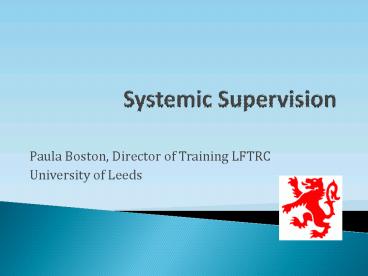Systemic Supervision - PowerPoint PPT Presentation
1 / 19
Title: Systemic Supervision
1
Systemic Supervision
- Paula Boston, Director of Training LFTRC
- University of Leeds
2
Aims
- Pro model musings
- Common factors in supervision
- What is systemic supervision
- Review several systemic principles that shape
supervision - Offer systemic skills that transfer to
supervision - Opportunities for practice
3
Offer a perspective on pro model of supervision
- Shared language and orientation
- Depth of skill development and theoretical
understanding - Theory as secure base
- Clarity of expertise and limits
- Meeting professional body requirements
- Mentoring and gate keeping
4
And on the other hand...
- Shared language and orientation self
referential - Depth of skill development and theoretical
understanding- may limit development - Theory as secure base can be rigid
- Clarity of expertise and limits how do you draw
the line - Meeting professional body requirements- may be
disconnected to organization agenda - Mentoring and gate keeping- may be complicated
5
Common factors in supervision
- a structured relationship between a supervisor
and supervisee . goal to help the supervisee gain
the attitudes, skills, and knowledge needed to be
a responsible and effective therapist. - development of clinical skills
- offering support and praise
- clinical competence and professional competence
- supervisor has a responsibility not only to
individual supervisees, but also to the
profession, or field as a whole.
6
- Much of the current writing about the supervisory
relationship emphasizes the need for supportive
collaboration (Carifio Hess, 1987 Carroll,
1988 Williams, 1994). - supervisory relationship as an indispensable
element can vary from a collaborative to a more
directive relationship . (Morgan, M. Sprenkle, D.
2007)
7
Back to pro model
- As has been suggested for clinical common
factors, we believe that specific models are the
medium through which the common factors work
(Sprenkle Blow, 2004), and which provide the
variety and diversity needed to match human
complexity.
8
- Furthermore, specific theoretical models will
always be especially well matched with particular
supervisors, and this synchrony will likely
positively impact their effectiveness for these
supervisors. call for family therapists to commit
themselves to a model of treatment
9
- hypothesis that a therapist will maximize his
therapeutic effectiveness if his practice is
consistently guided by a model that he has chosen
for the fit that the model provides with his
personal worldview. (Simon 2006)
10
- A recent investigation of therapy skills
suggested that experienced family therapists were
more likely to use interventions that included
taking both an expert stance as well as a
collaborative stance less - Less than five percent of the sample practiced
exclusively from one domain (Cornille, 2002).
11
What is systemic supervision?
- Draws on the systemic family therapy body of
knowledge (models, skills, code of ethics)
presumes previous mental professional training - AFT registered supervisor
- Incorporates modern realism with post modern
touch - Tends toward supporting strengths, resilience,
growth - Draws on developments in the field Nice,
evidence based practice, NHS and National
policies - Attends to context of the supervision manages
different positions - Variety of processes retrospective (verbal /
video taped) and live. micro skills and general
review
12
Key elements
- Attending to the relationship between supervisee
and client and supervisor and supervisee (meaning
of supervision) - Isomorphism modelling and parallel process
- Attending to power and hierarchy
- Developmental - ??? Balance of support and
difference or opinion - Supervisee centered agenda
- Preference for questions rather than
statements..no interpretations! Advice and
opinions
13
continued
- Attention to language used
- Attention to nonverbal or process information,
patterns - Inclusion of use of self but not therapy
- May include considerations of organizational
issues but is not interventive
14
Techniques
- Modelling - Its the copying that originates.
Michael White - Opportunity for consumer position
- Doing with rather than to
- And is only part of the process, some of the time
15
Review several systemic techniques
- Joining finding connections
- Learning narratives and history of supervision
- Circular questions mapping beliefs, behaviours
and relationships - Reflecting team discussion
- Internalized other interview
16
- Externalizing identifying the issue, mapping
its effects on therapist, constraints, unique
outcome - Solution focused goal setting, future oriented,
preparing, small steps, scaling
17
- Carifio, M. S., Hess, A. K. (1987). Who is the
ideal supervisor? Professional Psychology
Research and Practice, 18, 244250 - Cornille, T. A. (2002). How do experienced family
therapists view their practice? An exploratory
assessment of clinical skills and their relation
to theories of family therapy. Contemporary
Family Therapy, 24, 271288. - Carroll, M. (1988). Counseling supervision The
British context. Counseling Psychology Quarterly,
1, 387396.
18
- Morgan, M. Sprenkle, D. (2007) Toward a Common
Factors Approach toward Supervision. J. of
Marital and Family Therapy 33 (1), 117 Simon,
(2006) The Heart of the Matter A Proposal for
Placing the Self of the Therapist at the Centre
of Family Therapy Research and Training. Family
Process. 45 Issue 3, 331-345. - Simon (2006) The Heart of the Matter A Proposal
for Placing the Self of the Therapist at the
Centre of Family Therapy Research and Training.
Family Process 453. 331-345.
19
- Williams, L. (1994). A tool for training
supervisors Using the supervision feedback form
(SFF). Journal of Marital and Family Therapy, 20,
311315































